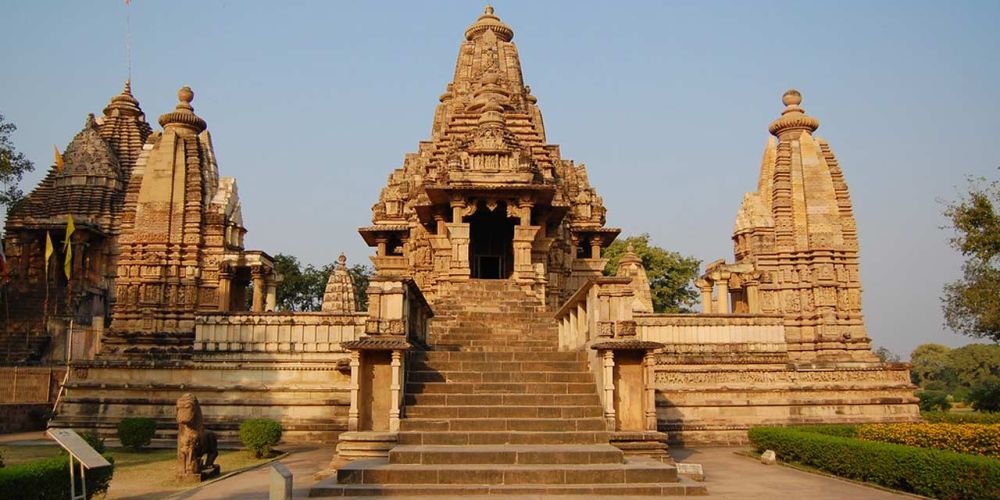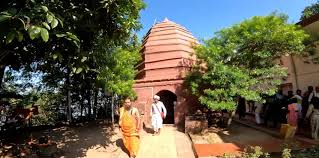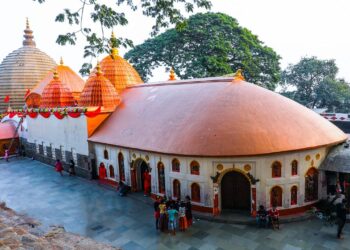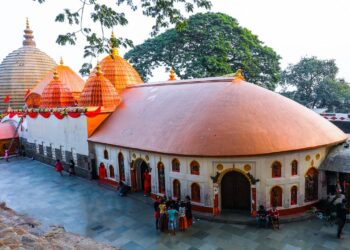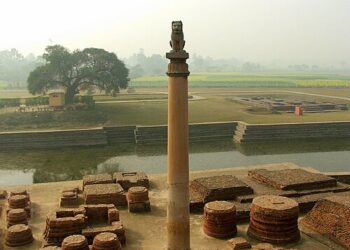Nestled among the ancient stones of Khajuraho, Madhya Pradesh, the Lakshmana Temple is a holy shrine where devotees pray to Lord Vishnu, famed for its fine stone carvings. Built in the 10th-century by Yashovarman during the Chandela dynasty, this temple, with its tall spire and grand art, draws people seeking blessings. It is dedicated to Vaikuntha Vishnu – an aspect of Sri Vishnu.
Notable Fact: The temple’s four-armed Vishnu idol and 600 carvings make it a UNESCO World Heritage site.
Mythological Significance
Lakshmana Temple carries old tales. One story says King Yashovarman, a Chandela lord, built it to honor Vishnu, who blessed his rule in a dream. Another tells of sages praying to Vishnu here, finding peace for their hearts. Folks say prayers bring calm and might. The temple’s tie to Vishnu links it to his role as the keeper of the world, standing proud in Khajuraho’s holy grounds. “Lakshmana” points to Vishnu’s form as Rama’s brother, showing loyalty and strength.
Historical Background
The temple’s roots go way back, built near 950 by Chandela kings. Khajuraho was a big city, full of faith. The Lakshmana temple was the first of several temples built by the Chandella kings in their newly-created capital of Khajuraho. Between the 10th and 13th centuries, the Chandellas patronized artists, poets, and performers, and built irrigation systems, palaces, and numerous temples out of sandstone. At one time over 80 temples existed at this site, including several Hindu temples dedicated to the gods Shiva, Vishnu, and Surya. There were also temples built to honor the divine teachers of Jainism. Approximately 30 temples remain at Khajuraho today.
The original patron of the Lakshmana temple was a leader of the Chandella clan, Yashovarman, who gained control over territories in the Bundelkhand region of central India that was once part of the larger Pratihara Dynasty. Yashovarman sought to build a temple to legitimize his rule over these territories, though he died before it was finished. His son Dhanga completed the work and dedicated the temple in 954 C.E.
Architecture of Lakshmana Temple
Lakshmana Temple sits on two acres in Khajuraho’s Western Group, made in Nagara style. The main shrine has a tall spire, 25 meters high, carved with gods, lovers, and beasts, all in yellow stone. Inside, the Vishnu idol, four-armed and black, holds a conch and disc, lit by ghee lamps. The inner walls got plain stone with old prayer words.
It is a Sandhara Temple of the Panchayatana Variety. The entire temple complex stands on a high platform (Jagati), as seen in image. The structure consists of all the elements of Hindu temple architecture. It has entrance porch (ardh-mandapa), Mandapa, Maha-Mandapa, Antarala and Garbhagriha. Unlike other temples in Khajuraho, its sanctum is Pancharatha on plan (top-view). Its shikhara is clustered with minor urushringas (refer images of temple top i.e. shikhara).
The central deity at the Lakshmana temple is an image of Vishnu in his three-headed form known as Vaikuntha who sits inside the temple’s inner womb chamber also known as garba griha—an architectural feature at the heart of all Hindu temples regardless of size or location. [4] The womb chamber is the symbolic and physical core of the temple’s shrine. It is dark, windowless, and designed for intimate, individualized worship of the divine
The wall portion is studded with balconied windows with ornate balustrades. It has two rows of sculptures (refer images of temple’s outer wall) including divine figures, couples and erotic scenes. The sanctum doorway is of seven sakhas (vertical panels). The central one being decorated with the ten incarnation of Vishnu. The Lintel depicts goddess Lakshmi in the centre flanked by Brahma and Vishnu. The sanctum contains four-armed sculpture of Vishnu. One of the niches has the image of the sculptor and his disciples at work.
Rituals and Festivals
The temple stirs for festivals. Janmashtami, in August, is big, with all-night chants and milk pujas for Krishna, Vishnu’s form. Diwali, in October or November, lights up for joy. Ram Navami, in April, honors Rama, another Vishnu form. Kartik Purnima, in November, draws devotees for prayers. Khajuraho Dance Festival, in February, mixes art with faith.
Information for Travelers
Hours and Entry: Open every day, 7:00 AM to 6:00 PM. Entry costs ₹30 for locals, ₹500 for foreigners. No pictures in the inner room.
Clothing: Wear clothes covering shoulders and knees. Women for prayers wear sarees or suits, men wear kurtas.
How to Get There:
Air: Khajuraho Airport, 5 km off, is closest. Taxis take 15 minutes, cost ₹200–400.
Train: Khajuraho Station, 3 km away, links to Delhi (12 hours). Autos cost ₹50–100.
Road: Buses from Jhansi (5 hours) reach Khajuraho. Taxis cost ₹2000–3000. Roads are calm.
Best Time to Visit: October to March is cool, 20–30°C. Weekdays are quiet. Janmashtami’s full, so plan early.
Nearby Attractions:
Kandariya Mahadeva Temple, 1 km away, is a Shiva shrine.
Matangeshwar Temple, 1 km away, has a tall linga.
Parsvanath Temple, 2 km away, is a Jain shrine.
Chaturbhuj Temple, 3 km away, honors Vishnu.
Devi Jagdamba Temple, 1 km away, is a Devi shrine.
